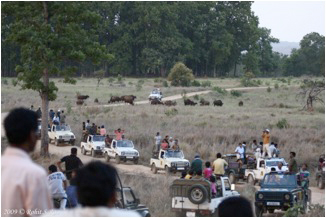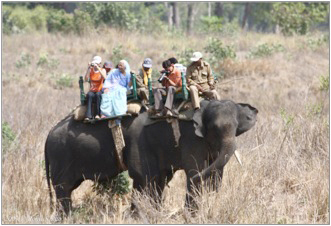A line of tourist jeeps clogs the road in a dry forest, as all eyes—and cameras—are on a big cat ambling along the road ahead; when the striped predator turns for a moment to face the tourists, voices hush and cameras flash: this is a scene that over the past decade has becoming increasingly common in India. A new study in Conservation Letters surveyed ten national parks in India and found that attendance had increased on average 14.9% from 2002-2006, but while rising nature tourism in India comes with education and awareness opportunities, it also brings problems.
Lead author of the study, Krithi Karanth, told mongabay.com that the main drive behind the nature tourism rise is India’s “growing affluent middle class with money to spend on holidays.” In fact, 80% of the tourists are domestic. Other trends behind the rise include “increased publicity and marketing for species, such as tigers.”
 Jeeps crowd a road in an Indian National Park. Photo by: Krithi Karanth. |
While more Indians visiting their wild lands and wildlife is generally a cause for celebration, it also raises concerns, chief among them a lack of funding for conservation and local communities seeing little benefit from tourism.
“Funding for improving protection can be much improved. Tourism revenue from an individual park is sent to larger treasury and so a individual park may not always benefit from their own revenues,” says Karanth adding that, “Tourism revenue should be distributed more equitably.”
Increased revenue from the rise in tourism is skipping local communities as well. According to Karanth revenue is largely ending up in “private hands”, with resorts and home stays “run by wealthier individuals and corporations” taking the bulk. Around some parks a trend of ‘land grabbing’ is occurring with “wealthy outsiders buying up local residents’ land at very high prices,” says Karanth.
For example, Karanth points out that “at one of India’s best parks it was estimated that 95% of revenue goes to private hands while the park gets less than 5% and local residents get less than 0.5%.”
Poorer local residents currently lack the resources to start their own tourism businesses. While they may be employed by tourism operations, positions are often seasonal and are low paying.
 Wildlife viewing by elephant is a common tourist experience in India. Photo by: Krithi Karanth. |
“Local communities need the resources and skills to establish their own facilities,” Karanth says otherwise “tensions will escalate around these parks.”
Booming tourism is also threatening unprotected lands adjacent to parks. According to the study, 72% of tourist facilities were constructed after 2000 and 85% of facilities are within 5 kilometers of the park.
Karanth says that authorities must “ensure that facilities are not constructed in critical wildlife corridors and prevent construction of walls and fences in areas adjacent to the park.”
In parks that contain healthy populations of tigers a different challenge emerge. In a new paper to be published by Oryx Karanth and colleagues have found that National Parks in northern and central India are heavily focused on one thing: the ‘tiger show’
In these parks, says Karanth, a “tourist visit is rated a failure or success based solely on sighting of a tiger. […] Tigers are a great umbrella species but tourists, guides, park managers have to be educated to appreciate other wildlife and wild places.”
Indeed, India is incredibly rich in wildlife. Nationwide there are 350 mammals, over 1200 birds, and nearly 600 reptiles and amphibians, not to mention a stunning diversity of plants many of them endemic.
To conserve these species, India’s parks are key. But in the midst of rising wildlife tourism, parks need to strengthen regulations. Karanth recommends that the number of allowable vehicles and visitors should be based on scientific findings, and that guidelines need to be set up for the use of land and local resources, such as water and fuel wood.
“In its current unregulated form tourism is a huge pressure on parks and park managers already facing other challenges. However, building support among millions of Indians for conservation is huge opportunity that should not be squandered,” Karanth concludes.
CITATION: Krithi K. Karanth and Ruth DeFries. Nature-based tourism in Indian protected areas: New challenges for park management. Conservation Letters. Volume 4, Issue 2, pages 137–149, April/May 2011. DOI: 10.1111/j.1755-263X.2010.00154.x.
Related articles
Parks key to saving India’s great mammals from extinction

(02/24/2011) Krithi Karanth grew up amid India’s great mammals—literally. Daughter of conservationist and scientist Dr. Ullas Karanth, she tells mongabay.com that she saw her first wild tigers and leopard at the age of two. Yet, the India Krithi Karanth grew up in may be gone in a century, according to a massive new study by Karanth which looked at the likelihood of extinction for 25 of India’s mammals, including well-known favorites like Bengal tigers and Asian elephants, along with lesser known mammals (at least outside of India) such as the nilgai and the gaur. The study found that given habitat loss over the past century, extinction stalked seven of India’s mammals especially: Asiatic lions, Bengal tigers, wild dogs (also known as dholes), swamp deer, wild buffalo, Nilgiri Tahr, and the gaur. However, increasing support of protected areas and innovative conservation programs outside of parks would be key to saving India’s wildlife in the 21st Century.
India says tiger numbers up, but expert raises doubts

(03/28/2011) According to the Indian government tigers have gone up by 225 individuals in the past four years, from 1,411 big cats to 1,636 today, a 16% increase. The new census, however, also counts 70 tigers in the Sundarbans, which were not included in the past census, making the new grand total 1,706 Bengal tigers (Panthera tigris tigris). But don’t raise champagne glasses just yet, renowned conservationist with Wildlife Conservation Society (WCS) and tiger expert, Dr. Ullas Karanth, sees serious issues with the new tally, including a methodology that “has not been made public in a scientifically acceptable manner” and depends on a big count every few years instead of comprehensive and reliable year-by-year tracking methods. Despite such doubts, the news has generally been greeted with accolades.
India commits $10 billion to expand forests
(02/25/2011) The Indian government has approved a bold plan to expand and improve the quality of its forests as a part of the nation’s National Action Plan on Climate Change. The reforestation plan, dubbed the National Mission for a Green India (NMGI), will expand forests by five million hectares (over 12 million acres), while improving forests quality on another five million hectares for $10.14 billion (460 billion rupees).